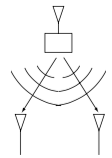
The downlink communication features a single transmitter (the base-station) sending separate information to multiple users. The baseband downlink AWGN channel with two users is $$ y_k[m]=h_k \cdot x[m]+ w_k[m] $$ where $w_k[m] \sim \mathcal{C N}\left(0,N_0\right)$ is i.i.d. complex Gaussian noise. and $y_k\left[m\right]$ is the received signal at user $k$ at time $m$, for both the users $k$ = 1, 2. Here $h_k$ is the fixed channel gain corresponding to user $k$ and indicates the condition of the channel. The transmit signal $x[m]$ has an average power constraint of $P$, which will be allocated to each user in the system.
Under asymmetric condition, when $\left|h_1\right|$ < $\left|h_2\right|$, NOMA follows this scheme: user 1 treats the signal of user 2 as noise and decodes its data from $y_1$, user 2 decodes the data of user 1 and substract the signal of user 1 from $y_2$ before decode its own data. The decoding process of user 2 is much like SIC. With the power allocation fraction $\beta$, the following rate pair can be achieved: $$ R_1= \log_{2}\left(1+\frac{P_1\left|h_1\right|^2}{P_2\left|h_1\right|^2+N_0}\right) $$ $$ R_2= \log_{2}\left(1+\frac{P_2\left|h_2\right|^2}{N_0}\right) $$ where $$ P_1=\beta \cdot P $$ $$ P_2=\left(1-\beta\right) \cdot P $$ $$ 0<\beta<1 $$
With orthogonal schemes, as introduced in slide 3, another fraction $\alpha$ is needed to split degree of freedom between users. For each combination of power split $\beta$ and degree-of-freedom split $\alpha$, the following rate pair can be achieved: $$ R_1= \alpha \log_{2}\left(1+\frac{P_1\left|h_1\right|^2}{\alpha N_0}\right) $$ $$ R_2= \left(1-\alpha\right) \log_{2}\left(1+\frac{P_2\left|h_2\right|^2}{\left(1-\alpha\right) N_0}\right) $$ where $$ P_1=\beta \cdot P $$ $$ P_2=\left(1-\beta\right) \cdot P $$ $$ 0<\alpha<1 $$ $$ 0<\beta<1 $$ Here, both fraction $\alpha$ and $\beta$ should be jointly optimized to compute the boundary.
There is one thing that has to be paid attention to: under symmetric condition, namely when $\left|h_1\right|$ = $\left|h_2\right|$, the performance of NOMA and OMA are the same. On the contrast, under asymmetric condition, NOMA outperforms OMA and the gap between them are more obvious when the asymmetry deepens.
In the next following slides, please choose values for channel gains with the order of $0< \left|h_1\right|\leq\left|h_1\right|\leq\ldots\leq\left|h_k\right|$
